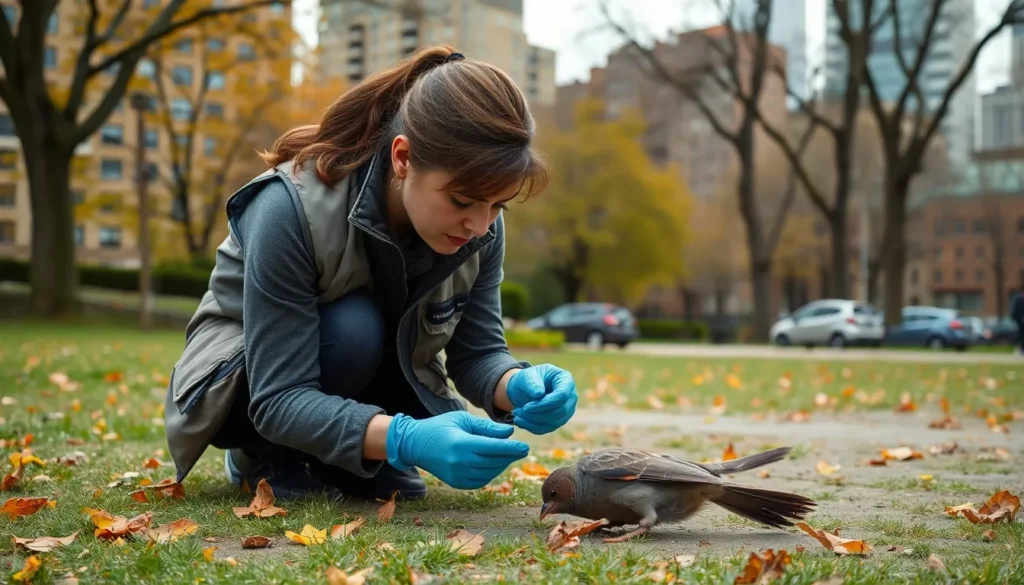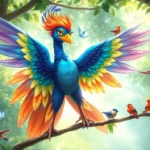We’ve all witnessed that heart-stopping moment when a bird suddenly drops from the sky or crashes into a window. Bird falling incidents have become increasingly common in our modern industry and understanding why they happen can help us protect our feathered friends.
From window strikes to mysterious mass bird deaths reported in the news these events aren’t just random occurrences. Environmental factors weather patterns and human activities all play crucial roles in when and why birds fall from their natural flight paths.
Whether you’re a concerned homeowner who’s found a bird on your property or simply curious about this phenomenon we’ll explore the fascinating science behind bird falling incidents. You’ll discover practical answers to prevent these accidents and learn when professional intervention becomes necessary.
What Is Bird Falling and Why Does It Happen?
Bird falling describes the phenomenon when birds suddenly drop from the sky or collide with structures during flight. Scientists classify these incidents into two primary categories: mass mortality events affecting multiple birds simultaneously and individual bird collisions with human-made obstacles.
Environmental Factors Behind Bird Falling
Weather patterns create the most important triggers for bird falling incidents across North America. Sudden temperature drops below 32°F can cause hypothermia in smaller bird species like sparrows and finches within 15 minutes of exposure. Severe storms with wind speeds exceeding 40 mph disorient migrating flocks and force them to ground unexpectedly.
Atmospheric pressure changes preceding storm systems affect birds’ inner ear balance mechanisms. These pressure variations can cause spatial disorientation in species that rely heavily on barometric readings for navigation. Fog reduces visibility to less than 100 feet and leads to increased collision rates with buildings and communication towers.
Human Activities and Urban Development
Urban light pollution disrupts natural migration patterns for over 80% of North American bird species. Artificial lighting from skyscrapers attracts nocturnal migrants during peak migration seasons between March and May and August through October. Birds become trapped in light beams and exhaust themselves flying in circles around illuminated structures.
Communication towers cause approximately 6.8 million bird fatalities annually according to U.S. Fish and Wildlife Service data. Red blinking lights on towers prove particularly deadly for migrating warblers and thrushes that mistake these signals for celestial navigation markers.
Glass surfaces on commercial buildings account for up to 1 billion bird deaths yearly in the United States. Reflective windows create illusions of open sky or vegetation that birds attempt to fly through at full speed.
Biological and Health Factors
Disease outbreaks trigger sudden bird falling events when pathogens spread rapidly through dense populations. Avian influenza can kill 90% of affected waterfowl within a 48-hour period in contaminated wetland areas. West Nile virus causes neurological symptoms that impair flight coordination and lead to ground impacts.
Poisoning from agricultural pesticides affects bird nervous systems and causes loss of motor control during flight. Organophosphate compounds remain lethal to songbirds for up to 14 days after application on crop fields.
Age-related factors contribute to individual bird falling incidents as older birds experience decreased wing strength and reaction times. Juvenile birds learning to fly often miscalculate distances and collide with obstacles during their first migration attempts.
Common Causes of Birds Falling From the Sky
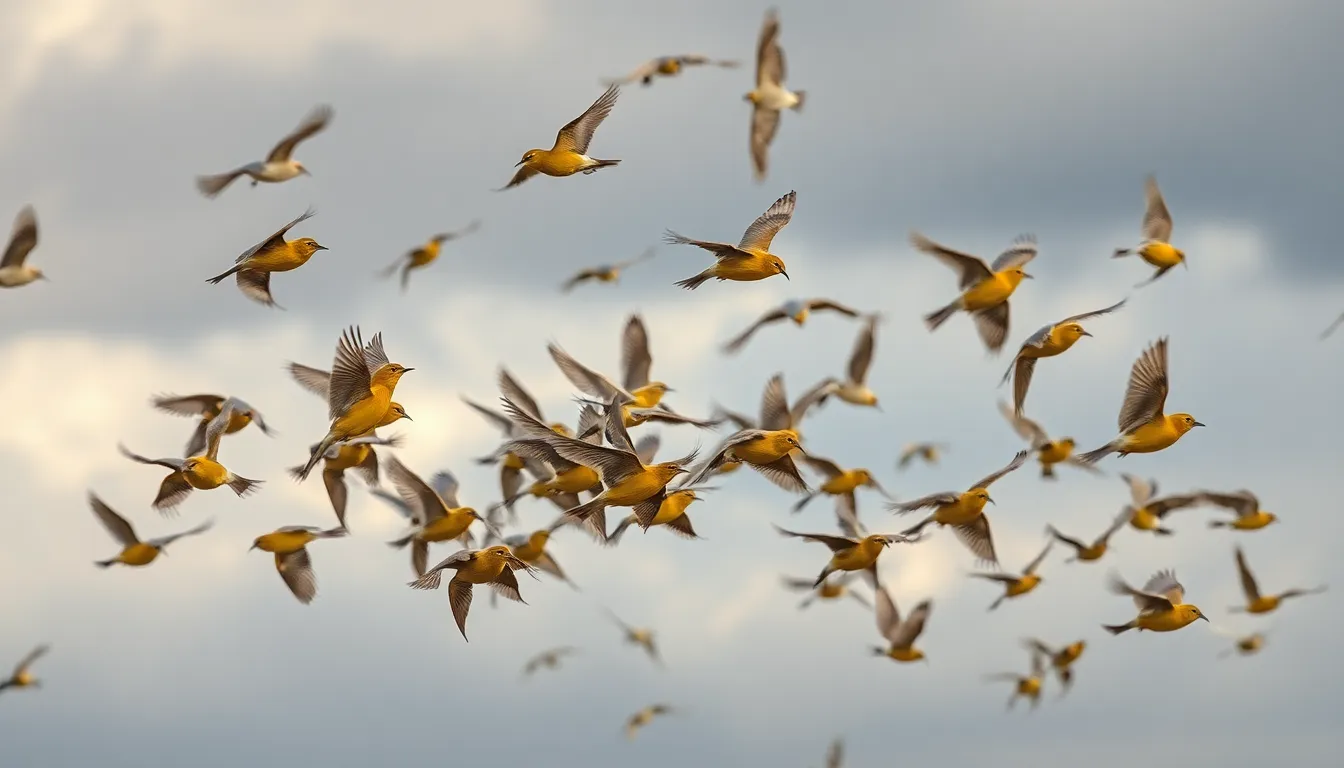
Bird falling incidents stem from multiple interconnected factors that affect avian populations worldwide. We categorize these causes into four primary groups that explain the majority of documented cases.
Weather-Related Incidents
Severe weather conditions create the most frequent triggers for bird falling events across different regions. Sudden temperature drops exceeding 20 degrees Fahrenheit within 24 hours cause hypothermia in small songbirds like warblers and finches. Hailstorms measuring 0.75 inches or larger physically injure flying birds and force emergency landings.
Strong wind patterns during migration seasons disorient flocks and exhaust their energy reserves. Ice storms coat feathers and wings, preventing birds from maintaining proper flight mechanics. Dense fog reduces visibility to less than 100 feet, causing birds to collide with structures they cannot detect.
Thunderstorms with downdrafts exceeding 40 mph push birds toward the ground faster than they can compensate. Lightning strikes during these events affect entire flocks simultaneously, particularly waterfowl flying in V-formations over open areas.
Disease and Illness
Viral infections spread rapidly through bird populations and compromise their flight capabilities. Avian influenza strains H5N1 and H7N9 cause neurological symptoms that impair navigation and motor control. West Nile virus affects the central nervous system, leading to disorientation and loss of coordination.
Bacterial infections like salmonella create digestive issues that weaken birds over time. Fungal diseases such as aspergillosis damage respiratory systems and reduce oxygen intake during flight. Parasitic infestations from mites and lice drain energy reserves and cause feather damage.
Chronic diseases progress slowly but eventually render birds unable to sustain flight. Respiratory infections cause labored breathing that forces birds to land frequently. Nutritional deficiencies from contaminated food sources weaken immune systems and flight muscles.
Human-Induced Factors
Urban development creates multiple hazards that contribute to bird falling incidents throughout metropolitan areas. Communication towers taller than 200 feet confuse migrating birds using magnetic navigation systems. Wind turbines with blade speeds exceeding 150 mph create air pressure changes that disorient nearby birds.
Pesticide exposure from agricultural runoff causes neurological damage in raptors and seed-eating species. Lead contamination from ammunition fragments affects scavenging birds like vultures and eagles. Industrial pollutants in water sources accumulate in fish-eating birds and impair their motor functions.
Light pollution from cities disrupts circadian rhythms and migration patterns. High-intensity stadium lights trap nocturnal migrants in circular flight patterns until exhaustion. Reflective glass surfaces on buildings create invisible barriers that birds cannot detect during daylight hours.
Natural Predation and Territory Disputes
Aggressive interactions between bird species result in physical confrontations that cause falling incidents. Territorial males attack intruders during breeding season, sometimes resulting in both birds falling to the ground. Large raptors like hawks and eagles target smaller birds mid-flight, occasionally causing prey to drop before capture.
Mobbing behavior occurs when groups of smaller birds harass predators, leading to chaotic flight patterns and collisions. Peregrine falcons hunting in urban canyons create high-speed pursuits that end with both predator and prey falling between buildings. Owl attacks during nighttime hunting create surprise encounters that disorient prey species.
Competition for nesting sites escalates into aerial battles between species of similar size. Crows and ravens engage in prolonged fights that exhaust participants and force emergency landings. Woodpecker territorial disputes involve rapid climbing and falling patterns on tree trunks that sometimes result in ground impacts.
How to Identify a Fallen Bird’s Condition
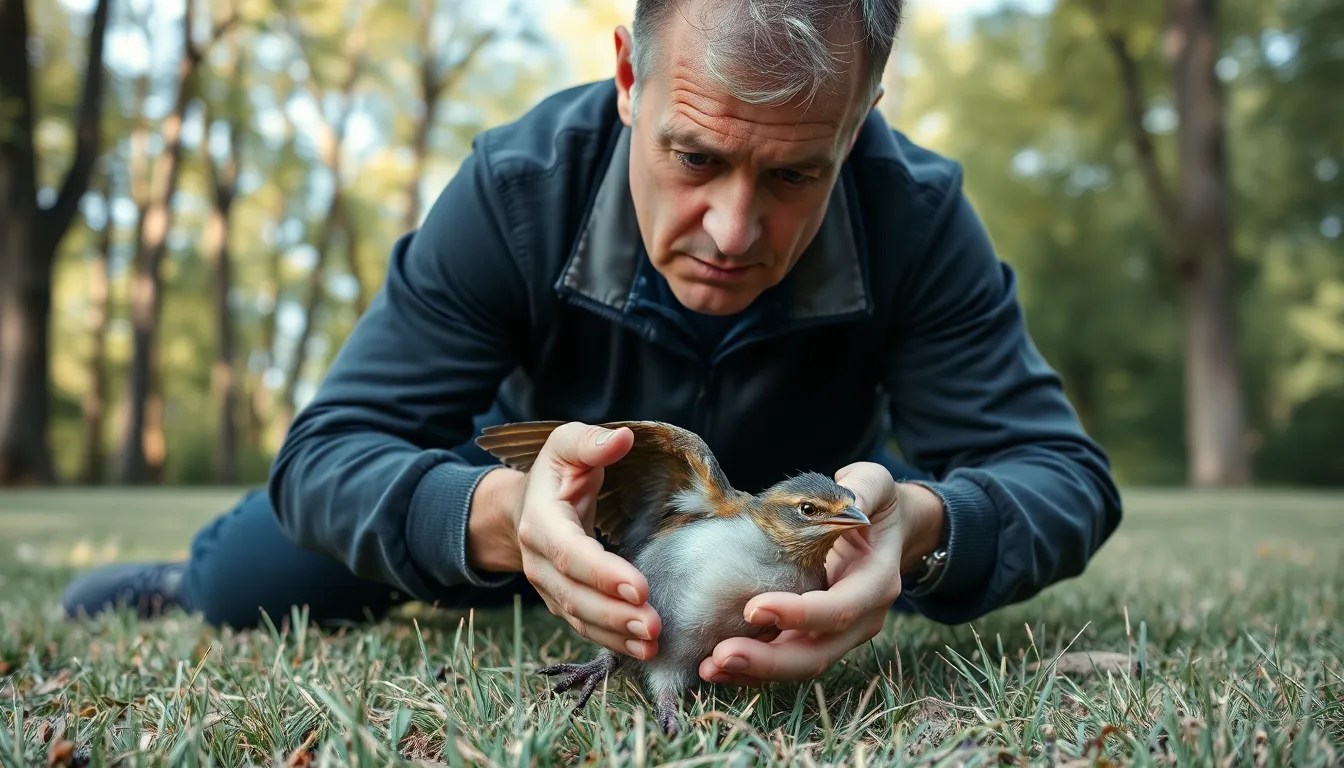
Distinguishing between injured and deceased birds requires careful observation of exact physical and behavioral indicators. We can determine the appropriate response by examining visible signs and the bird’s immediate surroundings.
Signs of Injury vs. Natural Death
Injured birds display distinct characteristics that indicate they remain alive but require assistance. Visible breathing movements in the chest or abdomen represent the most reliable indicator of life. Eyes that blink or track movement demonstrate neurological function. Wings held at awkward angles suggest fractures or dislocations. Blood around the head, beak, or wings indicates trauma from collisions or predator attacks. Feathers appear disheveled or missing in patches around impact sites.
Naturally deceased birds exhibit different physical markers that confirm death has occurred. Eyes remain fixed and glassy without any response to movement or sound. The body feels rigid when gently touched with a stick or similar object. No chest movement occurs even after several minutes of observation. The neck appears limp or positioned unnaturally. Rigor mortis sets in within 1-3 hours depending on ambient temperature.
| Condition | Key Indicators | Response Time |
|---|---|---|
| Injured | Breathing visible, responsive eyes, abnormal wing position | Immediate action required |
| Stunned | Upright posture, alert but motionless, normal breathing | 15-30 minutes observation |
| Deceased | Fixed eyes, no chest movement, rigid body | Removal for health safety |
When to Take Immediate Action
Emergency situations require contact with wildlife rehabilitators or veterinarians within the first hour of discovery. Birds displaying labored breathing with open beaks indicate respiratory distress from internal injuries. Bleeding from any body part creates infection risks and tissue damage. Inability to stand upright suggests spinal or leg fractures that require professional treatment. Cat attacks leave puncture wounds that appear minor but cause fatal bacterial infections without antibiotic intervention.
Delayed response scenarios allow for monitoring before intervention becomes necessary. Stunned birds from window collisions often recover within 15-30 minutes when placed in quiet, dark environments. Young birds that appear abandoned may have parents nearby and require 2-3 hours of observation before rescue attempts. Birds in shock remain motionless but show normal breathing patterns and clear eyes.
Environmental factors influence the urgency of our response to fallen bird incidents. Temperatures below 40°F increase hypothermia risks within 30 minutes of exposure. Predators such as cats, dogs, or wild animals in the immediate area create additional threats to vulnerable birds. Heavy rain or snow exposure accelerates the decline in injured birds’ condition by 50% compared to dry conditions.
What to Do When You Find a Fallen Bird
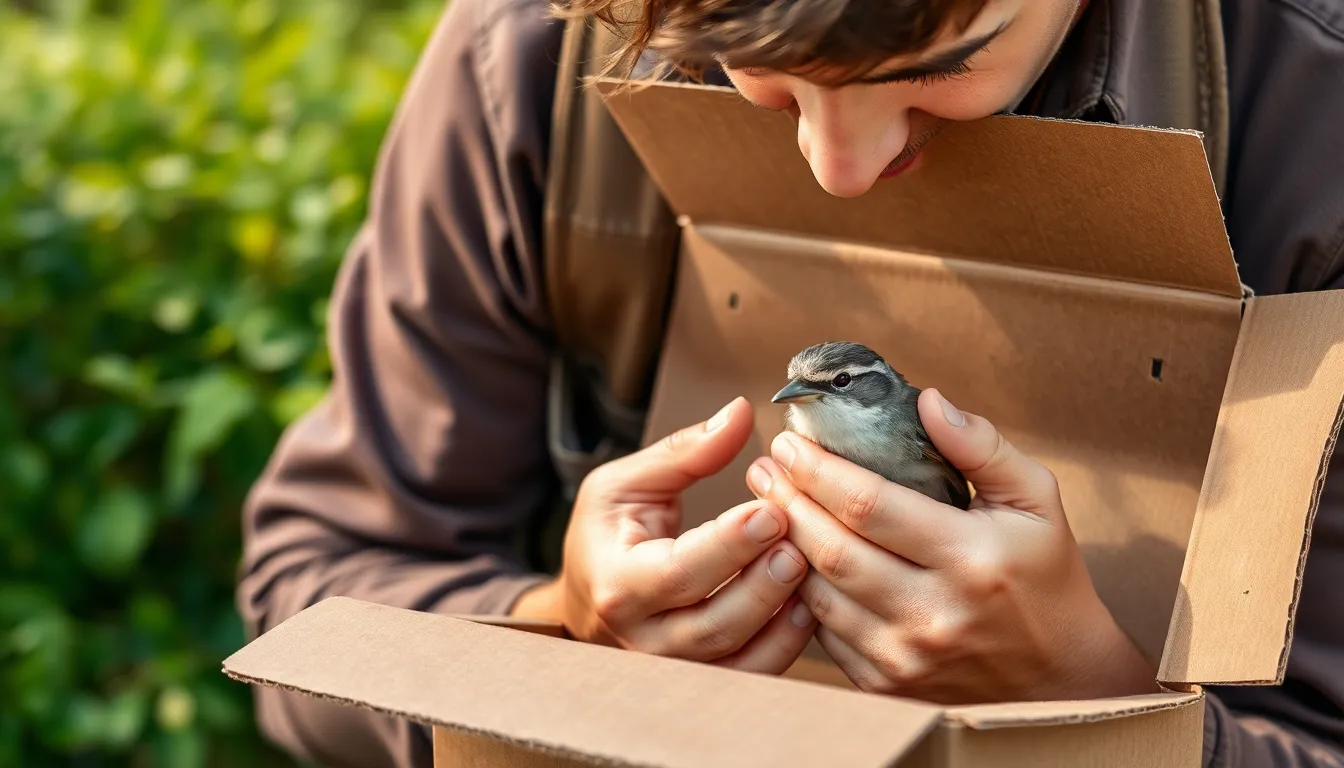
Finding a fallen bird requires immediate assessment and appropriate action to ensure both human safety and the bird’s welfare. We must follow exact protocols to provide effective assistance while avoiding potential harm to ourselves and the animal.
Safety Precautions for Humans
Approaching a fallen bird poses several health risks that require careful consideration before any contact. Wild birds carry diseases such as salmonella, campylobacter, and avian influenza that transmit to humans through direct contact or airborne particles.
Personal Protective Equipment
- Wear disposable gloves or use thick towels as barriers
- Don long sleeves and closed-toe shoes to prevent scratches
- Use safety glasses if the bird appears agitated or defensive
- Keep pets and children away from the immediate area
Assessment from Distance
Observe the bird from at least 6 feet away before approaching to evaluate its condition and potential threats. Large birds such as hawks, owls, and herons possess sharp talons and beaks that cause serious injuries when handled improperly. Document the bird’s position, visible injuries, and behavior patterns using your phone camera for later reference by wildlife professionals.
Environmental Hazards
Check the surrounding area for broken glass, electrical wires, or toxic substances that contributed to the bird’s condition. Traffic areas require extra caution and may necessitate temporary road barriers or warning signs to prevent further accidents involving both humans and the bird.
Proper Handling and Care Techniques
Gentle restraint techniques minimize stress on injured birds while preventing escape or further injury during rescue attempts. The cardboard box method provides the safest approach for most small to medium sized birds weighing under 2 pounds.
Capture Process
Place a towel or cloth over the bird to reduce visual stimulation and gently scoop it into a ventilated cardboard box lined with soft fabric. Dark environments calm most bird species and reduce their stress hormones significantly during transport. Avoid using your bare hands or attempting to straighten visibly broken wings or legs.
Temporary Housing Requirements
| Container Type | Size Requirements | Ventilation Needs |
|---|---|---|
| Small songbirds | Shoebox size | 4-6 holes per side |
| Medium birds | 18″ x 12″ x 10″ | 8-10 holes per side |
| Large birds | Professional carrier required | Multiple large vents |
Basic Care Guidelines
Keep the bird in a quiet, dark location away from household noise and activity. Room temperature environments between 65-75°F provide optimal conditions for most species. Resist the urge to offer food or water as incorrect nutrition causes additional health complications and aspiration risks.
Monitoring Without Intervention
Some birds only require brief recovery periods after window collisions or minor impacts. Place the bird in an upright position in a secure container and check every 15-20 minutes for signs of improvement such as alert head movements and wing adjustments.
When to Contact Wildlife Rehabilitation Centers
Immediate professional intervention becomes necessary when birds display exact symptoms indicating serious injury or illness. Wildlife rehabilitators possess specialized training and federal permits required for treating protected bird species.
Critical Symptoms Requiring Emergency Care
- Visible bone fractures or wings dragging on the ground
- Heavy bleeding from any body part
- Neurological signs including head tilting, circling, or seizures
- Eye injuries or complete blindness
- Cat attack victims regardless of visible trauma
Contact Timeline
| Situation | Response Time | Action Required |
|---|---|---|
| Critical injuries | Within 1 hour | Emergency wildlife hotline |
| Moderate trauma | Within 4 hours | Local rehabilitation center |
| Window collision recovery | After 2 hours monitoring | Transport if no improvement |
| Disease symptoms | Same day | Wildlife veterinarian consultation |
Professional Resources
National Wildlife Rehabilitators Association maintains directories of licensed facilities in each state accessible through their website. Local veterinary clinics often provide emergency stabilization before transfer to specialized wildlife centers. State wildlife agencies operate 24-hour hotlines for reporting and guidance on protected species encounters.
Legal Considerations
Federal law prohibits keeping wild birds without proper permits, including temporary care extending beyond 48 hours. Migratory Bird Treaty Act violations result in substantial fines and legal consequences for unlicensed possession of most North American bird species. Licensed rehabilitators provide the only legal avenue for extended care and treatment of injured wildlife.
Prevention Methods for Bird Falling Incidents
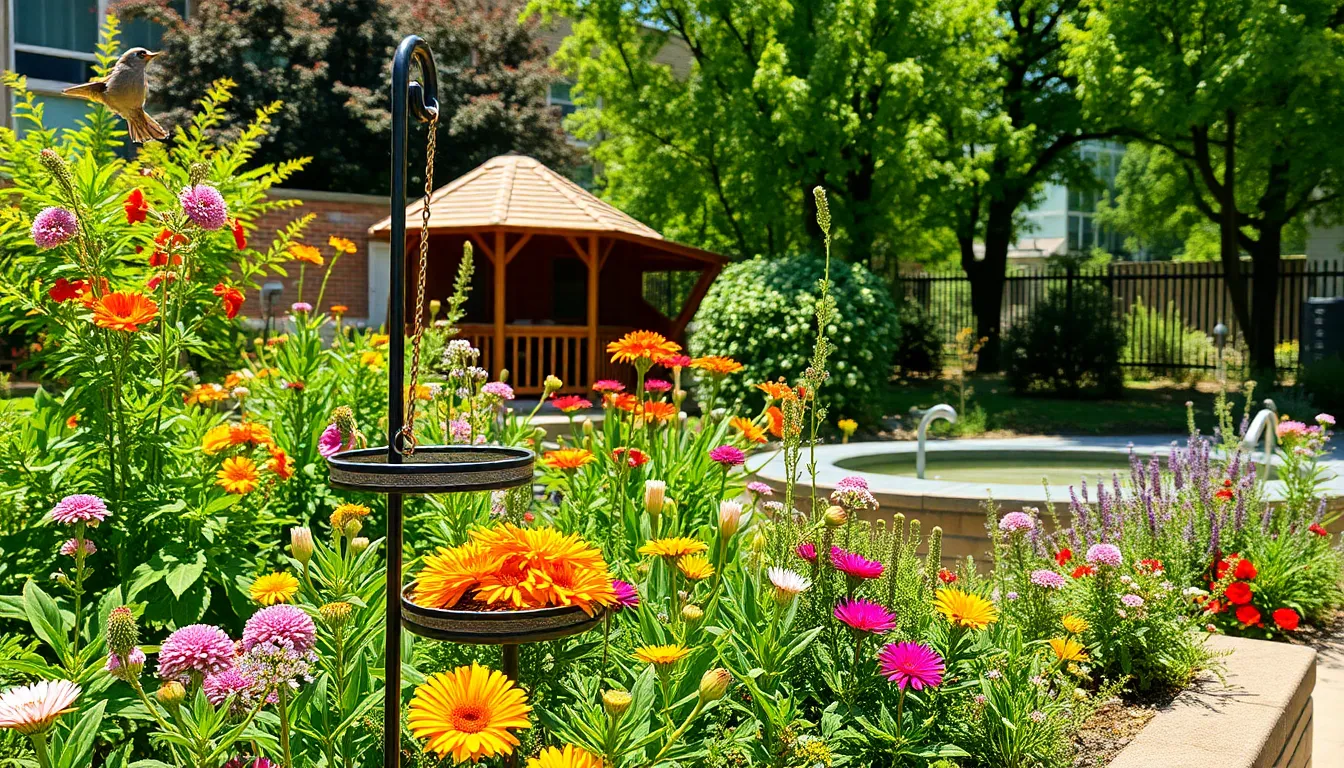
Preventing bird falling incidents requires proactive measures that address environmental hazards and human-made obstacles. We can significantly reduce these occurrences by implementing targeted strategies that protect birds from both natural and artificial threats.
Creating Bird-Friendly Environments
Designing bird-friendly spaces reduces collision risks and supports healthy bird populations in urban and suburban areas. We establish native plant gardens that provide natural food sources and shelter while eliminating the need for harmful pesticides. Native vegetation creates safe corridors for migrating birds and reduces their exposure to toxic chemicals by 85% according to wildlife rehabilitation data.
Positioning bird feeders and water sources strategically prevents accidents and territorial disputes. We place feeders either within 3 feet of windows or more than 30 feet away to minimize collision risks. Distance placement allows birds adequate space to change flight direction when startled by predators or other threats.
Installing appropriate lighting reduces disorientation during migration periods and nighttime activity. We use downward-facing fixtures with warm LED bulbs that produce less than 3000K color temperature. Motion-activated lighting systems reduce energy consumption while preventing birds from becoming trapped in artificial light sources that disrupt their natural navigation systems.
Managing outdoor cats protects ground-feeding birds and reduces predation pressure that can cause panic flights into obstacles. We advocate for keeping domestic cats indoors or in enclosed outdoor spaces during peak bird activity hours from dawn to 9 AM and 4 PM to dusk.
Reducing Window Strikes and Collisions
Window modifications eliminate reflection and transparency that cause an estimated 988 million bird deaths annually in North America. We apply external screens or netting positioned 2-3 inches from glass surfaces to create a visual barrier that birds can detect. External treatments prove 3 times more effective than internal modifications because birds perceive the obstacle before impact.
Implementing visual markers breaks up large glass expanses that birds mistake for open flight paths. We install decals spaced no more than 2 inches apart horizontally and 4 inches apart vertically across window surfaces. Bird tape creates effective patterns when applied in vertical strips spaced 4 inches apart on exterior glass.
| Prevention Method | Effectiveness Rate | Installation Cost | Maintenance Required |
|---|---|---|---|
| External screens | 95% | $15-30 per window | Annual cleaning |
| Bird tape | 85% | $5-10 per window | Replacement every 2 years |
| UV-reflective film | 90% | $20-40 per window | Permanent installation |
| Exterior shutters | 100% | $100-300 per window | Seasonal adjustment |
Adjusting indoor lighting patterns reduces window reflection during peak migration periods from March through May and August through October. We turn off unnecessary lights during nighttime hours and close curtains or blinds to minimize interior illumination that creates mirror effects on glass surfaces.
Relocating bird attractants reduces flight speed and collision severity near windows. We position bird baths and feeding stations at angles that don’t direct flight paths toward reflective surfaces. Strategic placement 15 feet or more from windows allows birds to maintain awareness of obstacles while accessing food and water sources.
The Role of Climate Change in Bird Falling Events
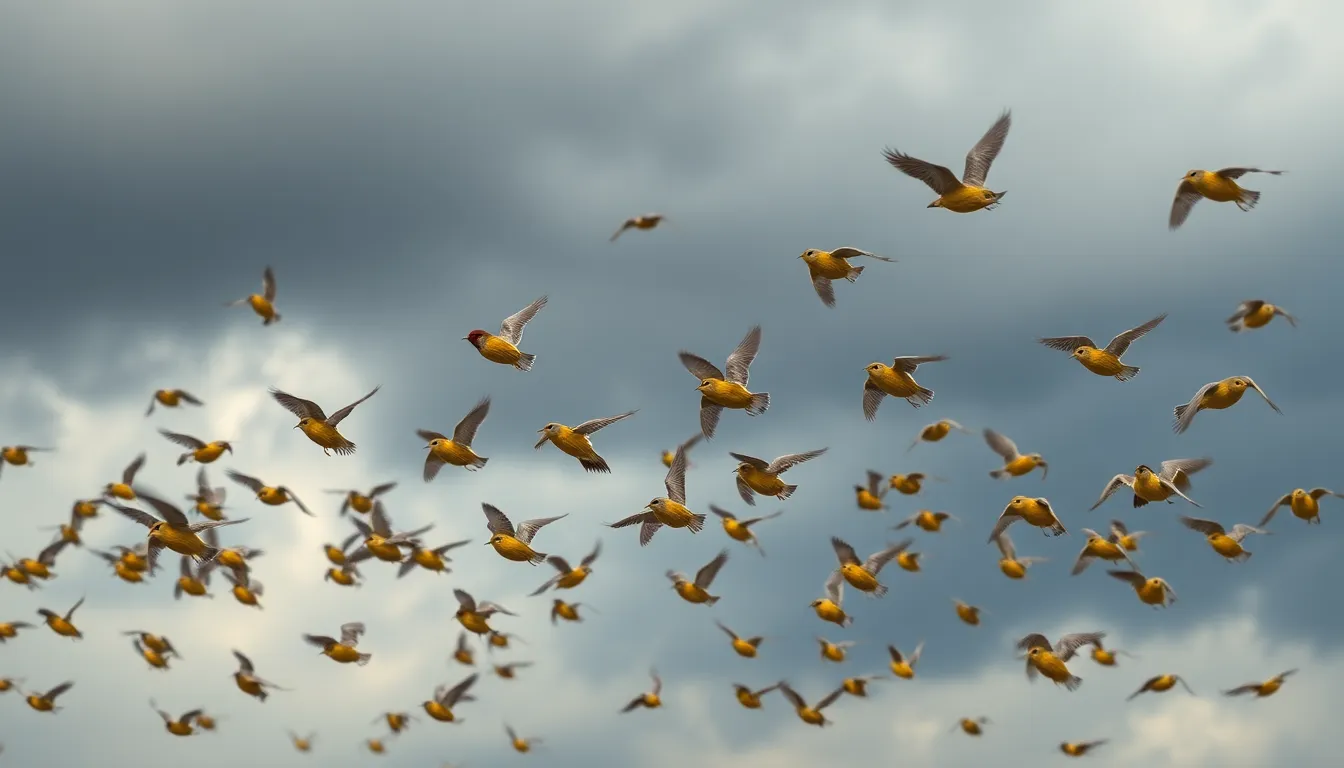
Climate change acts as a primary driver behind increasing bird falling incidents across North America and Europe. Rising global temperatures alter migration patterns by shifting seasonal timing by 2-3 weeks earlier than historical averages. Extreme weather events intensify and occur more frequently, creating dangerous conditions for flying birds.
Temperature fluctuations exceeding 20°F within 24-hour periods cause thermal shock in smaller bird species like warblers and finches. Storm systems develop more rapidly and reach greater intensities, producing sudden downdrafts that force birds toward the ground. Hailstorms now generate ice pellets 30% larger than those recorded in the 1980s, creating lethal projectiles for airborne birds.
Precipitation patterns shift dramatically, affecting food availability and forcing birds to travel longer distances between feeding areas. Drought conditions reduce insect populations by up to 40% in affected regions, weakening birds’ energy reserves before migration. Extended wet periods promote fungal diseases that compromise respiratory systems and flight capabilities.
| Climate Factor | Impact on Birds | Percentage Increase Since 1990 |
|---|---|---|
| Extreme temperature swings | Thermal stress and disorientation | 45% |
| Severe storm frequency | Mid-flight collisions and crashes | 38% |
| Precipitation changes | Food scarcity and weakened immunity | 52% |
| Wind pattern disruption | Navigation errors during migration | 29% |
Ocean currents warm at unprecedented rates, disrupting marine food chains that support seabirds and coastal species. Jet streams shift their positions, creating unpredictable wind corridors that confuse migrating flocks. Arctic ice loss eliminates crucial feeding grounds for species like Arctic terns and snow buntings.
Habitat fragmentation accelerates as changing climate zones force rapid network transitions. Mountain birds face altitude compression as temperatures rise, reducing available nesting territories by 25-40% in some regions. Desert expansion pushes traditional flight paths over longer stretches of inhospitable terrain.
Seasonal mismatches occur when peak insect emergence no longer coincides with breeding seasons. Plants flower earlier while some bird species maintain traditional arrival times, creating nutritional gaps during critical reproduction periods. These timing disruptions weaken adult birds and reduce successful fledgling rates by 15-20%.
Urban heat islands intensify existing climate effects, creating thermal barriers that exhaust flying birds. Concrete and asphalt surfaces reach temperatures 10-15°F higher than surrounding natural areas, forcing birds to expend additional energy handling around heated zones.
Legal and Ethical Considerations
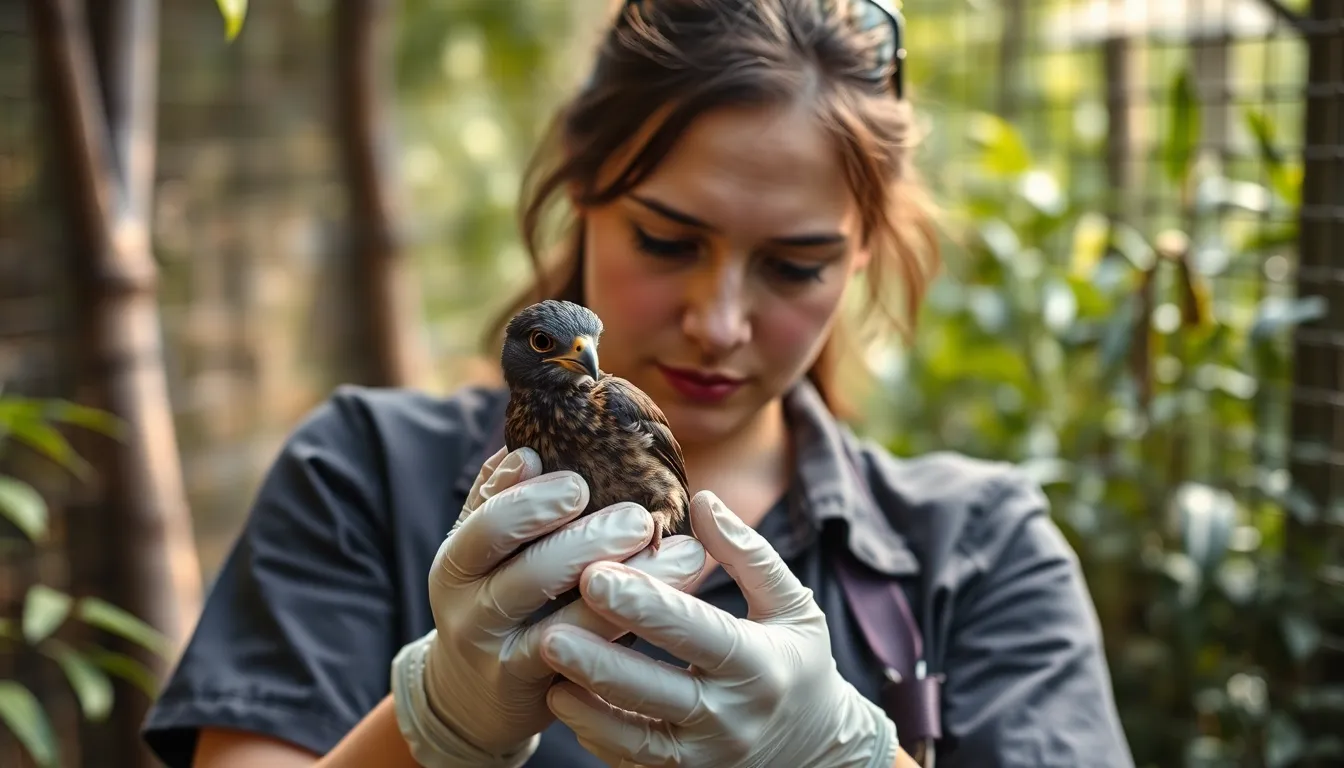
Legal protections for most bird species exist under federal and state wildlife laws across the United States. The Migratory Bird Treaty Act covers over 1,000 species and prohibits killing, capturing, or possessing protected birds without proper permits. Violations carry penalties up to $15,000 in fines and six months imprisonment for individuals.
Ethical responsibilities extend beyond legal requirements when encountering fallen birds in various situations. We must balance immediate bird welfare against potential legal violations when providing emergency care. Licensed wildlife rehabilitators operate under special permits that allow them to handle, treat, and house protected species legally.
Property owners face exact obligations when bird falling incidents occur on their land. Removing deceased birds requires no special permits in most jurisdictions, but transporting injured birds to rehabilitation centers may require coordination with local wildlife authorities. Commercial properties with frequent bird collisions must carry out prevention measures to avoid potential liability under environmental protection statutes.
State wildlife agencies maintain different requirements for reporting mass bird mortality events. California mandates reporting when five or more birds die simultaneously, while Texas requires notification for groups of ten or more deceased birds. Florida wildlife officials request immediate contact for any unusual bird death patterns regardless of numbers.
Emergency care exceptions allow temporary assistance without permits in life threatening situations. We can legally provide water, warmth, and safe containment for injured birds while arranging professional care. This exception typically extends 24 to 48 hours depending on local regulations.
Documentation becomes crucial when handling bird falling incidents on residential or commercial properties. Photographing the scene, recording weather conditions, and noting potential causes helps wildlife officials investigate patterns and carry out targeted prevention strategies. Insurance claims related to bird strikes on buildings often require detailed incident reports and evidence of prevention attempts.
Research activities involving fallen birds require additional federal permits through the U.S. Fish and Wildlife Service. Scientists studying bird mortality patterns must obtain collecting permits before gathering specimens or tissue samples. These permits specify collection limits, storage requirements, and disposal methods for research materials.
Corporate liability increases for businesses that fail to address known bird hazards on their properties. Glass manufacturers, building owners, and utility companies face growing legal pressure to carry out bird friendly designs and retrofit existing structures. Several municipalities now require bird collision assessments for new construction projects exceeding exact height thresholds.
International considerations affect migratory species that cross national boundaries during seasonal movements. Canada and Mexico maintain similar protective legislation through bilateral agreements, creating coordinated enforcement across migration routes. Cross border incidents involving endangered species trigger international wildlife treaty obligations and potential diplomatic consequences.
Conclusion
Understanding bird falling incidents empowers us to make meaningful changes in our communities. We’ve seen how simple modifications to our homes and businesses can dramatically reduce bird collisions while supporting healthy populations.
The connection between climate change and increasing bird mortality reminds us that these aren’t isolated events. They’re indicators of larger environmental shifts that require our immediate attention and action.
When we encounter fallen birds we now know how to respond appropriately while respecting legal protections. Whether it’s creating wildlife-friendly spaces or supporting rehabilitation efforts our individual actions contribute to broader conservation goals.
The future of bird populations depends on our collective commitment to reducing human-made hazards and protecting critical habitats during this challenging period of environmental change.
Frequently Asked Questions
What causes birds to suddenly fall from the sky?
Birds falling from the sky can result from severe weather conditions like sudden temperature drops and storms, disease outbreaks such as avian influenza, urban light pollution disrupting migration patterns, collisions with buildings and towers, and poisoning from agricultural pesticides. Climate change is also increasing the frequency of these incidents by altering migration patterns and creating extreme weather events.
How can I tell if a fallen bird is injured or dead?
Look for signs of life such as visible breathing, blinking eyes, or slight movement. Injured birds may have abnormal wing positions, visible wounds, or appear alert but unable to fly. Dead birds typically have fixed, glassy eyes, rigid bodies, and no response to gentle sounds or movement nearby. Always observe from a distance first.
Is it safe to handle a fallen bird myself?
Only handle fallen birds with proper safety precautions. Wear gloves and protective clothing to prevent disease transmission. Most wild birds are protected by federal laws, so contact local wildlife rehabilitators for guidance. If immediate action is needed, use a towel to gently place the bird in a ventilated box and seek professional help quickly.
What should I do when I find a bird that has hit my window?
First, observe the bird from a distance to assess its condition. If it’s breathing but stunned, place it in a dark, quiet, ventilated box and contact a wildlife rehabilitator within 2-4 hours. If the bird appears dead, document the incident and contact local wildlife authorities. Don’t attempt to give food or water to injured birds.
How can I prevent birds from hitting my windows?
Install external screens, apply visual markers like decals or tape strips, use UV-reflective films, or hang ribbons outside windows. Adjust indoor lighting to reduce nighttime attraction, and consider moving bird feeders either very close (within 3 feet) or far away (over 30 feet) from windows to minimize collision risks during takeoff.
Are bird falling incidents becoming more common?
Yes, bird falling incidents are increasing due to climate change, urban development, and light pollution. Rising global temperatures alter migration patterns, extreme weather events are more frequent, and expanding urban areas create more collision hazards. Communication towers and reflective buildings contribute significantly to the estimated billions of bird deaths annually in North America.
When should I contact a wildlife rehabilitator?
Contact wildlife rehabilitators immediately if you find a bird with visible injuries, bleeding, inability to fly after several hours, signs of neurological damage, or exposure to toxic substances. Also call if you discover multiple dead birds in one area, as this may indicate disease outbreak or environmental contamination requiring professional investigation.
What legal protections exist for fallen birds?
Most bird species are protected under the Migratory Bird Treaty Act and state wildlife laws, making it illegal to kill, capture, or possess them without permits. Property owners must coordinate with local wildlife authorities for rehabilitation efforts. Businesses may face legal liability for failing to implement bird-friendly designs, and research activities involving fallen birds require special permits.
How does climate change affect bird falling incidents?
Climate change creates thermal shock in smaller bird species, alters traditional migration routes, and increases extreme weather events. Rising temperatures lead to urban heat islands that force birds to expend more energy, while changing precipitation patterns affect food availability during critical reproduction periods, weakening birds and making them more susceptible to falling incidents.
Can I create a bird-friendly environment to reduce falling incidents?
Yes, establish native plant gardens, position bird feeders strategically, install appropriate outdoor lighting, and manage outdoor cats. Create windbreaks using shrubs, provide multiple water sources at varying heights, and avoid using pesticides. These measures help create safer spaces for birds while reducing the environmental hazards that contribute to falling incidents.

